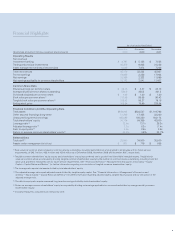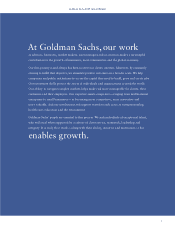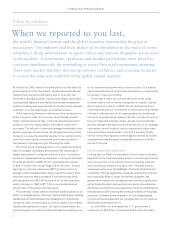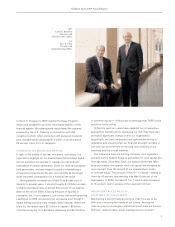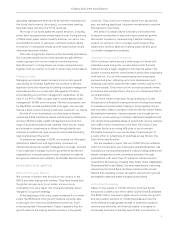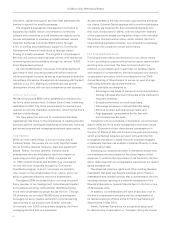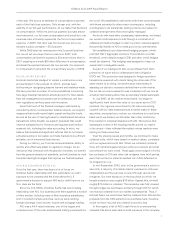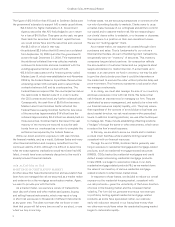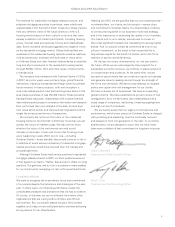Goldman Sachs 2009 Annual Report Download - page 8
Download and view the complete annual report
Please find page 8 of the 2009 Goldman Sachs annual report below. You can navigate through the pages in the report by either clicking on the pages listed below, or by using the keyword search tool below to find specific information within the annual report.
6
education, capital and support services best addresses the
barriers to growth for small businesses.
The program’s business and management curriculum is
supported by a $200 million commitment to community
colleges and universities to build educational capacity and to
provide scholarships to underserved small business owners.
GoldmanSachs has committed $300 million through
a mix of lending and philanthropic support to Community
Development Financial Institutions to help get capital
owing to small businesses. The program’s critical support
services will connect small business owners with mentoring,
networking and advice available through our various 10,000
Small Businesses partners.
As with 10,000 Women, the people of GoldmanSachs will
give freely of their time and professional skills to serve as
mentors and guest lecturers, as well as to participate on selection
committees. We believe this approach is in keeping with the best
tradition of our rm, aligning our philanthropic and growth
development efforts with our core competencies and expertise.
GoldmanSachs Gives
We also announced a $500 million philanthropic contribution to
the rm’s donor-advised fund, GoldmanSachs Gives, which was
established in 2007. The rm’s compensation for partners was
reduced to fund this charitable contribution, re ecting the rm’s
tradition of philanthropy.
We have asked our partners to recommend charitable
organizations that focus on the critical areas of creating jobs and
economic growth, building and stabilizing communities, honoring
service and veterans and increasing educational opportunities.
OUR PEOPLE
While an often used phrase, it is true in every way at
GoldmanSachs: Our people are our most important asset.
We do not have material “property, plant and equipment”
assets. Rather, we have talented, entrepreneurial
professionals who are dedicated to the rm’s mission of
supporting economic growth. In 2009, our people sat
on 1,500 nonpro t boards, and 23,000 of us volunteered
for over 800 local nonpro ts through our Community
TeamWorks program. In short, our people are central to
who we are, to the cohesiveness of our culture, and to our
ability to generate attractive returns for shareholders.
Throughout 2009, we stayed true to our focus on people.
Every member of our management committee participated
in on-campus recruiting, while another 120,000 recruiting
hours were undertaken by people across the rm. Through
GS University, we provided 350,000 hours of training and
leveraged our senior leaders as faculty to provide learning
opportunities to our people more broadly. Last year,
for example, over 5,000 courses were taught by the rm’s
managing directors and vice presidents.
As demonstrated in the way we source opportunities and serve
our clients, GoldmanSachs operates with a one- rm philosophy.
Our people are rewarded for their accomplishments by how
they work and succeed in teams, with the long-term interests
of the organization always coming before those of the individual.
We believe this partnership ethos, which re ects the rm’s
long-standing business principles, is a competitive advantage
that drives the company’s overall performance.
PAY FOR PERFORMANCE
Providing the best advice and execution to our clients means,
in turn, providing our people with attractive career opportunities
and long-term incentives. We have not been blind to the
attention on our industry and, in particular, on GoldmanSachs,
with respect to compensation. We have adopted very speci c
compensation principles, which we presented at our 2009
Annual Meeting of Shareholders to ensure an even stronger
relationship between pay and performance.
These principles are designed to:
• Encourage a real sense of teamwork and communication,
binding individual short-term interests to the institution’s
long-term interests;
• Evaluate performance on a multi-year basis;
• Discourage excessive or concentrated risk taking;
• Allow us to attract and retain proven talent; and
• Align aggregate compensation for the rm with
performance over the cycle.
Consistent with our principles, in December, we announced
that for 2009 the rm’s entire management committee would
receive 100percent of their discretionary compensation in
the form of Shares at Risk which have a ve-year period during
which an enhanced recapture provision will permit the rm
to recapture the shares in cases where an employee engaged
in materially improper risk analysis or failed suf ciently to raise
concerns about risks.
Enhancing our recapture provision is intended to ensure that
our employees are accountable for the future impact of their
decisions, to reinforce the importance of risk controls to the rm
and to make clear that our compensation practices do not reward
taking excessive risk.
The enhanced recapture rights build off an existing clawback
mechanism that goes well beyond employee acts of fraud or
malfeasance and includes conduct that is detrimental to the rm,
including conduct resulting in a material restatement of the
nancial statements or material nancial harm to the rm or one
of its business units.
In addition, our shareholders will have an advisory vote on
the rm’s compensation principles and the compensation of
its named executive of cers at the rm’s Annual Meeting of
Shareholders in May 2010.
Finally, GoldmanSachs does not set aside an actual pool
for discretionary compensation or “bonuses” during the course
Goldman Sachs 2009 Annual Report


